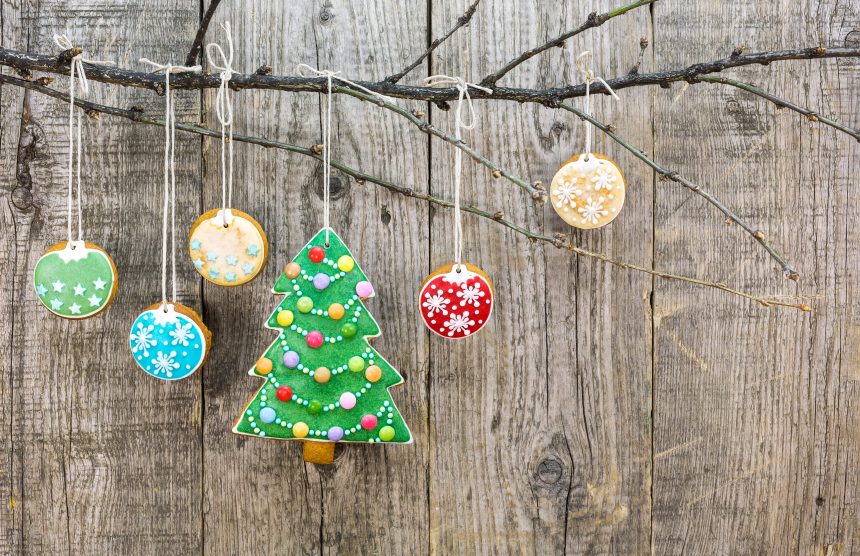Decorations
Display a Christmas tree decorated with flags from different countries.
Refreshments – Christmas Cookie Recipes from Around the World
Invite the women to bring a sample of their favorite Christmas cookie or dessert and share the recipe. The website www.Christmas-Cookies.com offers recipes of cookies from around the world. Once on the site, click on the gingerbread man at the top and scroll to the bottom. Click on “around the world.” If time allows, break the women into groups and have them try some of the recipes as part of your gathering.
Craft – Cookie–Cutter Ornaments & Cookies
Cookie–cutter ornaments make great sentimental gifts. Use inexpensive aluminum cookie cutters and patterned papers or photos copied onto card stock. Trace around the cutter and cut out. Dab white craft glue along cutter’s edge. Press paper in place and let dry. Thread a narrow ribbon through a hole poked between the paper and cutter. Slip a bead over the ribbon’s ends and knot. Check Pinterest for images and further instructions.
Traditions and Customs Around the World
Invite the women to share their Christmas traditions and customs.
The following are some traditions and customs from around the world:
- For the past 40 years, the town of Gävle in Sweden has erected a giant goat made of straw to mark the beginning of the holiday season.
- In Caracas, Venezuela roads are closed to motor traffic by 8 am from December 16 to December 24. People go to early morning mass on roller skates.
- Christmas crackers (cardboard tubes wrapped in decorative paper twisted at the end) are popular in the United Kingdom and Commonwealth countries. When two people pull on an end, it splits with a bang, and whoever holds the larger end wins a party favor.
- In the Czech Republic, on Christmas Day, single people throw a shoe over their shoulder. If the shoe lands with the toe pointing to the door, they will be married soon.
- Families in Finland usually visit the graves of their ancestors and relatives on Christmas Eve and light candles in memory of the deceased. Also, it is customary to enjoy a sauna on Christmas Eve before Santa’s visit. According to the ancient custom, this ritual cleanses the body and mind.
- In the Spanish culture, the holiday season begins in November at Thanksgiving and keeps going through January 6th—Three Kings Day or Epiphany. Epiphany is a Christian Holy Day celebrating the Magi’s visit to the Christ child.
- Jamaicans dress in elaborate costumes and celebrate Christmas with parades and “Junkanoo” Junkanoo is an African dance. The festival, which occurs on Boxing Day (the day after Christmas) may have begun as early as the 16th century.
- Children in Holland receive presents from Sinterklaas on December 5, not Christmas Eve or Christmas Day. If they leave carrots for Sinterklaas’s horse, he’ll leave sweets for the children.
- Children in Japan receive their Christmas presents on their pillow during Christmas night. A traditional Christmas meal in Japan is fried chicken.
- In Russia, Christmas is celebrated on January 7th and Babouschka brings gifts to children. Babouschka, meaning old woman or grandmother in Russian, is based on the story of the woman who didn’t give a gift to the baby Jesus. So, to repent, she gives gifts to children.
- In Germany, it is traditional for children to decorate their Christmas lists with pictures and leave them on the windowsill overnight. The Christkind (“Christ–child”) delivers gifts at Christmas. It is also a tradition to leave a shoe or boot outside the front door on December 5th so that Sinterklaas will put small presents in their shoes for the following morning (Saint Nicholas Day).
- Italian families celebrate Christmas Eve with the Feast of the Seven Fishes and eat lentils during the holiday season to ensure luck and wealth for the following year. Children in Italy receive gifts from LaBefana, an old woman who delivers gifts to children in a similar way to St. Nicholas or Santa Claus.
Christmas Traditions in Our Homes
It has become the tradition in our house to decorate our house for Christmas on Thanksgiving weekend. All the totes are brought down from the storage closet and so begins the unpacking of our treasures. After the tree is decorated and other symbols of the season are scattered around the house, we open up the tote that contains our collection of nativity sets. Our Willow Tree set remains on the mantel all through the year. The small nativities are displayed around the living room with the largest one on the fireplace hearth. This one has sentimental value because it was given it to us by my mother–in–law, who had it made for us 30 years ago. My husband is in charge of unwrapping each piece and placing it just right with the baby Jesus as the focal point. Although each nativity set is unique, it reminds us of the same amazing story: a Baby was born into the world who brought salvation to us all.
We read in Isaiah 9:6, “For a child is born to us, a Son is given to us. The government will rest on His shoulders. And He will be called: Wonderful Counselor, Mighty God, Everlasting Father, Prince of Peace.”
What a great reminder for us. This was a Child born to ordinary people but He was destined for greatness. Our traditions and customs are an important part of us because they keep us grounded and connected to our family and our culture. But most important among these traditions is our celebration of this newborn King!

